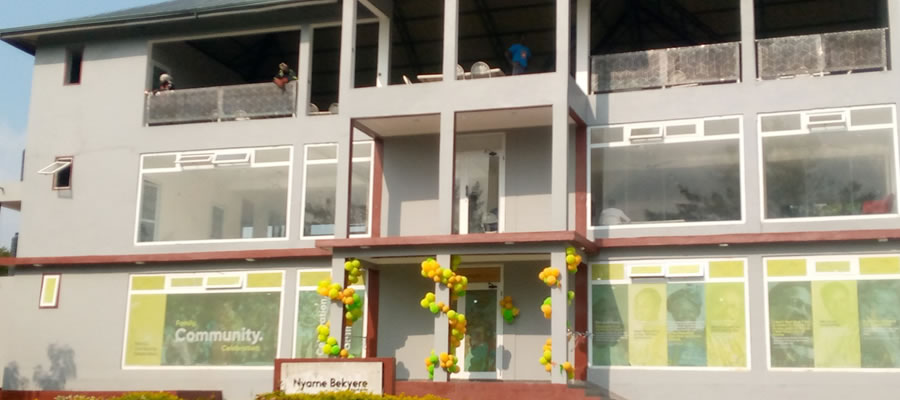

Action Plan
This section focuses on the programmes to be implemented in the medium term. As indicated in the framework, the selection of projects is influenced by the GPRS II document and the needs of the local people as presented in section one, situational analysis. Again another thrust of the medium term plan is to build the foundation upon which the long term development aspiration can be consolidated. The components of the programme of action include the projects to be implemented, the location of the projects, timeframe, source of funding as well as the responsible implementing/monitoring and evaluation agencies. The programme of action takes cognizance of the GPRS II Thematic areas.
Programme Planning Matrix (the Logical Framework)
Planning for logic and quality of development plans reqiures attention to detail. The goal of logic and quality planning is to assure that the output of the plan would be achieved- that Is, it would do what it is supposed to do. The quality and logic plan also establishes the criteria of performance by which the plan output would be measured when it is completed. For the purposes of this plan the programme planning matrix (also known as the Logical Framework) has been as a tool for doing logical and quality planning.
The Logical Framework (or log frame) is a planning and management tool that aims to promote good programme design by clearly stating the key components, how the plan is expected to work, and how success will be measured. It ensures that the whole planning process is considered before the work begins thereby avoiding problems that may be costly and difficult to address at a later stage. The log frame worksheet is divided into five rows: Goal, Purpose, Outputs, and Inputs; and four columns: Narrative, Objectively Identifiable Indicators, Means of Verification, and Assumptions. The five rows constitute a hierarchy of accomplishments, in which achievements within the categories toward the bottom contribute to achievements within the categories toward the top. The four columns represent descriptions and conditions associated with the plan goal, purpose, outputs, and inputs. Each of these categories is briefly discussed below.
The Overall Goal
The overall goal is the aim or end toward which the plan purpose is directed. A goal is broad statement of intention and an entire programme may be directed toward the achievement of the goal. Generally, a goal is not achieved by one programme alone, but is the end toward which a variety of programmes are aimed.
The Purpose
The purpose is the overall objective which the plan is designed to achieve. The achievement of the purpose should contribute directly to the achievement of the goal. For instance, a plan purpose could be to reduce client dependency on drugs and alcohol, while the overall goal may be to eliminate drug or substance abuse in the country.
The Outputs
Programme outputs are the specific outcomes to be produced by means of the programme inputs. The outputs may be quantitative, such as number of clients in progress; qualitative, such as the development of more effective counseling practices; and attitudinal, such as increased awareness of community agencies with supporting services.
The Inputs/Activities
Programme activities are the specific actions undertaken to accomplish the project outputs.The logical frameworks for the respective GPRS II pillars and cross-cutting development issues are as presented.
Narrative Summary
Capacity of governance institutions at the District level strengthened
1. Construct 20 housing units and 3 office accommodation
2. Undertake yearly on the job training and orientation
3. Establish and maintain non-functional Departments
4. Acquire 10 computers, 25 motorbikes and 40 bicycles
5. Facilitate the recruitment of additional staff
6. Organize annual training and orientation session for Assembly Persons
7. Establish effective monitoring and evaluation systems
8. Create incentive and motivational packages Output 2: Participation of the grass root in development and governance increased
9. Conduct regular sensitization (six monthly) of the citizenry
10. Promote effective coordination between the traditional authority and governance institutions
11. Organize annual public hearing and discussions on development and governance issues
12. Organize routine conflict resolution and management session
13. Construct Town and Area Council offices
14. Staff Town Area Council offices Output 3: Revenue generation level increased
15. Establish effective revenue generation system
16. Organize yearly training session for revenue collecting staff
17. Organize quarterly functional education on taxation and civic responsibility programmes
18. Expand external finance resources sources Output 4: Effective and efficient allocation and utilization of economic resources enhanced
19. Promote regular auditing
20. Establish of effective expenditure system
21. Strengthen the local government inspectorate Output 5: Incidence of crime and delinquency among the youth minimized
22. Establish watch dog committees in all major towns and villages
23. Strength the capacity of the police and other security agencies
24. Establish police post in all main towns
25. Establish counseling and rehabilitation centers Output 6: Incidence of disaster reduced and prevented
26. Strengthen the capacity of NADMO
27. Undertake bi-monthly public education on disaster prevention and management
28. Establish afforestation schemes in top twenty communities Output 7: Coordination and collaboration among stakeholders enhanced
29. Organize annual public education on peace building
30. Conduct bi-yearly conflict management session for stakeholders
31. Define, clarify and disseminate the roles and responsibilities among stakeholders
Programme of Action for the Medium Term
The application of the programme planning matrix provided the tool and instrument for effecting comprehensive monitoring and evaluation of the plan implementation and for managing the development process for the accomplishment of the stated development goals and objectives.
This planning and management tool also provided the opportunity for presenting the entire plan is a concise and meaningful format for ease of understanding and dissemination of the development activities and intentions therein. The programme of action segment of the plan indicates the extend of resource commitment and requirements, the spatial implications of the plan, the responsible agencies for implementation, financing and monitoring, the time frame for the outlined activities and the participating actors as well as the intended beneficiaries of the development efforts. Tables present the details of the programmes of action for the medium term. These followed by the programmes of action for the 2007 financial year.
Indicative Financial Plan
Preliminary estimates indicate that the total cost of the Medium Term Development Plan k ¢72,263,000,000. Out of this amount of 034,283,000,000; 028,584,000,000; anc ¢7,845,000,000 are required to implement the projects under private sector-lec competitiveness, human resource development and good governance and civil responsibility respectively. It is expected that the District Assembly would finance ten percent from internal sources while the remaining 90% would be met from external sources. Notable among the external sources are the DACF, HIPC Relief,Central Government supported projects and the Private Sector.
It is anticipated that bilateral and multilateral agencies such as EU, DFID, World Bank, KFW, Embassies and High Commissions, and other International development interventions would contribute substantially to the finances of the development plan. Also other local initiatives like the Otumfuo’s Educational Fund, NGOs and Civil Society Organizations, local communities, Traditional Authorities and citizenry are all expected to contribute their quota towards the successful implementation of the Plan.
The Assembly would have to strengthen its revenue mobilization drive to be able to generate adequate resources locally to reduce its dependence on external funding. Investment prospectus and proposals need to be prepared to place the Assembly in competitive position to attract more external funding.
Date Created : 11/23/2017 12:57:05 AM













 facebook
facebook
 twitter
twitter
 Youtube
Youtube
 +233 593 831 280
+233 593 831 280 0800 430 430
0800 430 430 GPS: GE-231-4383
GPS: GE-231-4383 info@ghanadistricts.com
info@ghanadistricts.com Box GP1044, Accra, Ghana
Box GP1044, Accra, Ghana